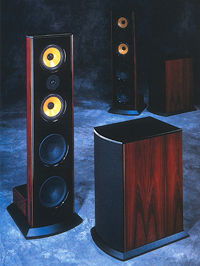| Columns Retired Columns & Blogs |
That is an amusing and rather creative "serial number" listed in the specifications.
 Since many of the major design features common to both speakers were described in depth in the Dvorak review, only the most salient characteristics shared by the Beethoven are revisited here. Those interested in a more complete analysis of the fundamental principles behind these unusual speakers are encouraged to track down the Dvorak review.
Since many of the major design features common to both speakers were described in depth in the Dvorak review, only the most salient characteristics shared by the Beethoven are revisited here. Those interested in a more complete analysis of the fundamental principles behind these unusual speakers are encouraged to track down the Dvorak review.
The Beethoven...
...is essentially a Dvorak on steroids. Each main panel contains five top-of-the-line ScanSpeak drivers. Two custom-made 10" paper/carbon-doped woofers handle the panel's bass response up to 200Hz, at which point they cross over to two 8" Kevlar-coned midbass units arranged in a symmetrical array above and below a custom version of the Revelator, ScanSpeak's premier silk-dome tweeter.
The 8" and 10" drivers are not attached to the front baffle with screws. Audio Artistry pressure-fits these drivers via the rear spine; the drivers are sandwiched between the spine and the back of the baffle, where their front rims fit into precisely routed cavities filled with a special damping material. This mounting technique is said to reduce driver distortion and the transfer of vibrations to the front panel, and gives the baffle a beautifully clean appearance. Each of these drivers has a vented pole-piece; corresponding holes along the spine accommodate the required venting.
Two wide strips of grillecloth run from top to bottom on either side of the rear spine to give the speaker a neat, finished appearance. This cloth also conceals absorptive material used to attenuate higher frequencies radiating from the rear wave of the 8" midrange drivers. In conjunction with the use of a monopole tweeter, this damping is consistent with Audio Artistry's contention that dipole radiation of treble frequencies is undesirable.
Seated on the rear two-thirds of each main-panel plinth is a detachable passive crossover box. This enclosure is chock-full of very-high-quality passive components. Large polypropylene caps, heatsunk Caddock power resistors, and air-core inductors handle frequency division and impedance compensation between each of the main-panel drivers. Three sets of quality Cardas binding posts are mounted on the top rear of the crossover box for optional (and recommended) tri-wiring of the main panel. A harness of Cardas conductors connects the binding posts to a three-way Neutrik SpeakOn connector, which in turn attaches the crossover to the speaker via its mating half, located near the bottom rear of the main panel. This arrangement provides flexibility and allows easy upgrading of the crossover without having to send the speaker back to the factory. In addition, the crossover box is isolated from panel vibrations via effective E.A.R. damping feet.
Rather than assign each speaker a serial number, Audio Artistry mounts a large copper nameplate engraved with a unique name, typically related in some way to Beethoven's music, on the top of each passive crossover.
Each Beethoven subwoofer cabinet is open to the front and back and contains four 12" drivers. David Copperfield must have been consulted to figure out how to squeeze four large woofers inside a box this compact. The drivers are arranged so that their back-and-forth motion partially cancels vibrations generated by each driver, resulting in very little transfer of resonant energy to the cabinet and floor.
The two main panels and tops of each subwoofer cabinet are finished in gorgeous mirrorlike "piano black" lacquer. Solid rosewood is used for the narrow side panels and rear center spine, and is grain-matched to the veneer on the side of each woofer.
The active crossover, housed in a metal chassis fitted with a black anodized faceplate, can feed either a pair of stereo amps or two sets of monoblocks. This crossover handles the 100Hz transition between panels and woofers and performs equalization both above and below this crossover point. The EQ above 100Hz helps achieve a smooth frequency response from the panel's dipole drivers, while below 100Hz the EQ corrects for the dipole woofer's natural rolloff, resulting in a nearly flat response down to 20Hz. If you have a very small room or a limited budget, you can use the main panels alone. In such cases the woofer section is turned off, extending the main panel's response down to around 40Hz.

That is an amusing and rather creative "serial number" listed in the specifications.